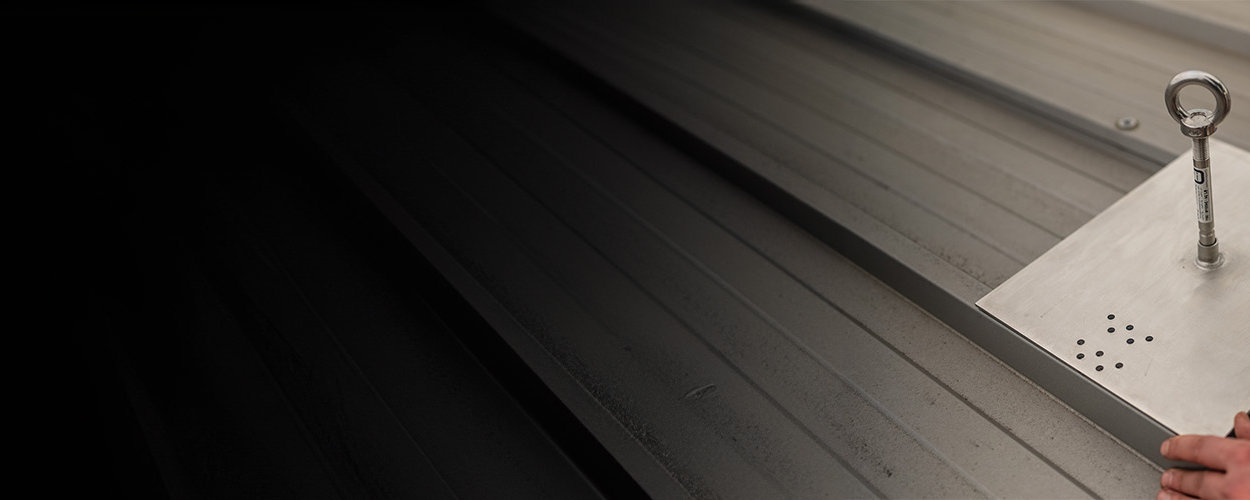Temporary side protection
Temporary side protection is used to effectively secure fall edges on construction sites. This consists of customised or prefabricated components such as posts, rails and toe boards, the requirements of which are specified in the EN 13374 standard.
Guardrails are collective protective devices that offer equal protection to all persons on the roof. They are therefore favoured over individual protective measures with personal fall protection equipment (PPE).
Classification of side protection systems
Side protection systems are divided into different protection classes to meet specific requirements and loads:
Protection class A: This class is designed for situations in which static loads occur, for example by leaning against, holding on to, running against or falling against. The system ensures stability and safety in such scenarios.
Protection class B: These are systems that are designed for both static loads and minor dynamic loads. This includes activities such as leaning, holding on, running against, falling against or impacting after sliding on inclined surfaces.
Protection class C: This class is specifically designed to withstand large dynamic loads that can be caused by falling or sliding on steeply inclined surfaces. Such systems offer robust protection in demanding environments.
Safety requirements for side protection systems
The requirements for side protection systems are precisely formulated to ensure effective protection:
Regardless of the design, all side protection systems must have a minimum height of 1 m. A toe board with a height of at least 150 mm is required at the bottom, unless the surface is fitted with a parapet at least 150 mm high.
The distance between two sections of the side protection must not exceed 120 mm in the case of interruptions.
In the case of class A side protection with knee rails (intermediate rail), these must be designed in such a way that a ball with a diameter of 470 mm cannot fit through them. If the bars are arranged vertically as an alternative, they may have a maximum distance of 250 mm.
For class B side protection systems, regardless of the design, no ball with a diameter of 250 mm may pass through. Systems with intermediate bars therefore require several bars arranged one above the other.
The angle between the roof surface and the side protection must be between 75° and 105° for classes A and B.
For a class C side protection, a ball with a diameter of 100 mm must not fit through. The side protection must be aligned between the vertical and a line at right angles to the roof surface in order to meet the highest safety standards.
Your benefits with our guardrail systems
Discover the numerous advantages of our guardrail systems:
Self-supporting design: Specially designed side protection system for use on flat roofs.
Tested safety: Our systems are tested and certified in accordance with EN 13374 Class A.
Compliance with standards: Meets the requirements of DGUV-I 201-056 and ÖNORM B3417.
Easy installation: Quick and economical installation thanks to innovative plug-in connections (Plug & Safe).
Low risk of tripping: Minimizes the risk of tripping thanks to counterweights that are only 5 cm high (commercially available concrete paving slabs).
Optimum height: railing height of 1.10 m for maximum safety.
Flexible post spacing: Post spacing of up to 2.5 m possible.
Versatile use: Can be used on flat roofs with a slope of up to 10°.
Time-saving installation: Quick and uncomplicated installation thanks to pre-assembled system components.
Roof penetration-free: Ensures safe use without roof penetration.
Can be extended as required: The system can be extended as required.
Variable design: All angles can be realized thanks to flexible corners.
Adaptable: Free end or wall termination possible.
Unevenness compensation: Compensation for unevenness, steps or other height differences on the roof is possible with flexible angle elements.
Why are guardrails and toe boards used?
Guardrails and toe boards play a crucial role as essential components of system scaffolding and roof safety scaffolding, in addition to the usual façade scaffolding. The presence of guardrails on at least two sides of a scaffold is essential to ensure the safety of the scaffold.
Guardrails and toe boards serve as primary measures for the basic securing of scaffolding. They effectively prevent scaffolding parts, tools and equipment from falling out and protect personnel working on the scaffolding from dangerous falls.
INFO: How high must a toe board be?
The toe board, also known as a skirting board, must have a minimum height of 5 cm. This requirement helps to create an effective safety barrier and prevent accidents.
What is meant by three-part side protection?
A three-part side guard is an essential safety device for scaffolding, consisting of a guardrail, an intermediate rail and a foot guard. This protective measure is installed along the edges of the scaffolding to effectively minimize potential fall hazards.
INFO: Exceptions to use
There are specific situations in which the use of the three-part side protection can be deviated from, for example when the scaffolding is erected inside a building or alternative safety measures are taken. Nevertheless, a thorough risk assessment is essential to ensure that the safety of workers and the public is adequately guaranteed in every situation.
Contact us
Questions about planning or installation? We are here for you! Contact us for professional advice.
